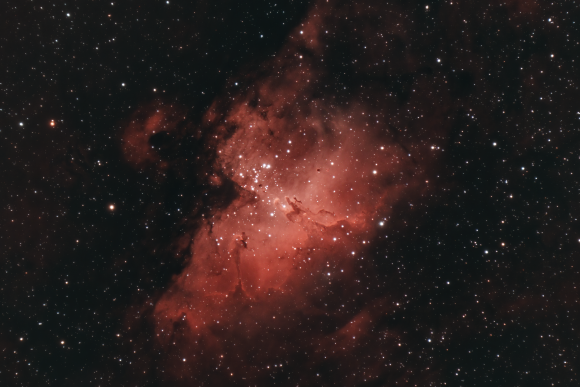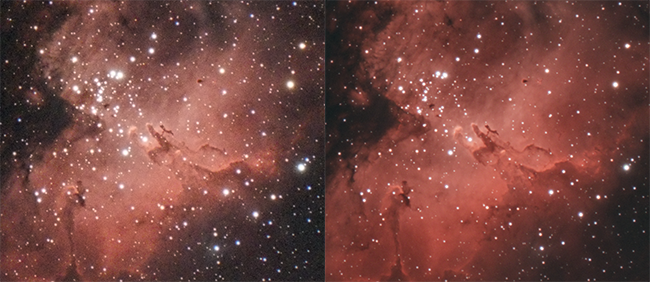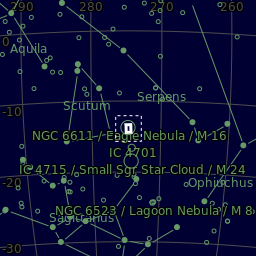 Click here for an annotated version of this target.
Click here for an annotated version of this target.
M16 also known as the Eagle Nebula is one of the most distinctive targets on the Messier Catalog. M16 is a reflection/emission nebula and a star cluster. The Eagle refers to the dark area in the center of the nebula. This area was made famous by the “Pillars of Creation” imaged by the Hubble Space Telescope in 1995. There are several active star-forming regions in this nebula.
M16 is about 5700 light-years away and lies in the constellation of Serpens.
I took this image over two nights. The first night I took 18 frames at 300 seconds and the second night I took another 26 at 300 seconds. I used the Optolong L-Pro filter the first night. I was intending to use the same filter the second night, however, as I was testing back focus with the L-eNhance before starting my sequence I forgot that I left that in. I’m sure I could have had some “brighter” data with the L-Pro filter, however, I’m still happy with my results.
I was impressed by how much noise is reduced from just having more data. I think even the star field and color depth is enhanced with just two extra hours of data. This was a great learning experience for me.
 This is why we stack. Left we have 18 x 300 seconds, right we have 44 x 300 seconds.
This is why we stack. Left we have 18 x 300 seconds, right we have 44 x 300 seconds.
Noise reduction is the biggest advantage of more data.
Processing Info
I stacked the 44 light frames along with 40 dark and 50 flat frames in PixInsight
The following processes were performed in PixInsight:
- Dynamic Crop
- Automatic Background Extraction
- Photometric Color Calibration
- MultiScale Linear Transform
- Histogram Transformation
- Curves Transformation (X2 with a range mask. Inverted mask for the background and then non inverted for the target)
- Morphological Transformation (Generated StarMask using default settings)
- Local Histogram Equalization (Performed with a range mask)
Once I found what I liked, I saved the files and went to Photoshop, and ran Topaz AI DeNoise. This is an amazing plugin that works like magic.
If anyone is curious here are the full-res versions of the images.
 Here you can see the area of the sky in Serpens imaged.
Here you can see the area of the sky in Serpens imaged.
Acquisition Data
- Telescope: Explore Scientific ED127 Air-Spaced Triplet Apochromatic Refractor
- Camera: ASI071MC Pro
- Guide Scope: Orion ST80
- Guide Camera: ASI290MM Mini. Dithering every image at 1 pixel each time.
- Mount: iOptron CEM60
- Software: NINA for image acquisition. PixInsight used for stacking and editing. Imported to Photoshop for final touchup and watermarking.
- Other Accessories: AstroZap Dew Heater, Explore Scientific 2″ Field Flattener, MoonLite CFL 2.5″ Focuser, High Res Stepper Motor, V3 Controller, Pegasus Astro Power Box Advance
- Filters: Optolong L-Pro 2″ on night one and Optolong L-eNhance 2″ on night two
- Exposure Time: Night 1: 1 hour 30 minutes (18 x 300 seconds) 0°C. Night 2: 2 hours 10 minutes (26 x 300 seconds) -5°C
- Exposure Start: 23:09 & 22:54
- Date: July 19 & 21, 2020
- Location: Voorhees State Park, NJ, United States
- GPS Coordinates: Lat. 40.68187, Long. -74.89797
- Temperature: 74°F/23.3°C
- Bortle Dark-Sky Scale: 4
- Astrometry.net job: 3832039
- Avg. Moon age: 28.26 Days
- Avg. Moon phase: 1.8%
- RA center: 18h 18′ 47″
- DEC center: -13° 51′ 57″
- Orientation: 88.361 degrees
- Field radius: 0.630 degrees
- Magnitude: 6.0
- Resolution: 3720 x 2330
